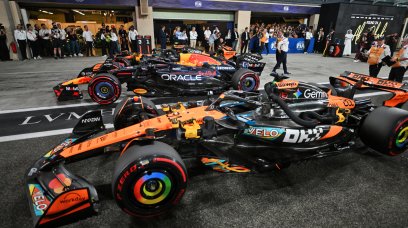After the opening two grands prix in Bahrain and Saudi Arabia, all the teams have started - but only a few have completed - the process of understanding their cars.
Ferrari has emerged as second-fastest behind Red Bull, with a deficit of about four-tenths of a second per lap as Charles Leclerc and Carlos Sainz's cars are the only ones to have shown a progressive improvement from the 2023 machinery, with the obvious exception of Red Bull, of course.
Whilst the SF23 had proven to be a project limited by its architecture, the same cannot be said of the current car, which is based on a different concept, starting with a rethought chassis.
The cooling system packaging and power unit accessories are also different from the 2023 car, although not as extreme, but thanks to an evolution of volumes and shapes, the team has been able to obtain a different distribution of aerodynamic load, creating a strong and stable aerodynamic centre of pressure and balance.
Even the suspension - which has remained unchanged with its push rod at the front and pull-rod at the rear - has had its geometries and kinematics perfected with some fine-tuning, with the enhanced aerodynamic concept benefiting from this stable and functional platform.
Alongside the strong points, in Saudi Arabia especially, the weaker aspects of the SF24 that need to be corrected were discovered, with the developments needed to bridge the gap to the RB20 primarily set to resolve the problem of slow tyre warm-up.
Viewed by others:
Ferrari's SF-24 upgrades
The slowness of the SF-24 in firing its tyres into the ideal operating temperature clearly emerged and whilst the excellent balance of the car was evident in both Bahrain and Saudi Arabia, at the Jeddah Corniche Circuit it was necessary to complete two full laps to enter the ideal thermal window.
This indicates that the overall downforce of the car, especially in that configuration, was not sufficient to induce enough energy on the tyres, something immediately grasped by the Maranello engineers, who adopted a flatter rear-wing main profile.
After identifying the lack of downforce from the floor, Ferrari is hoping to solve the problems with upgrades that are already in the pipeline.
They should be ready to be deployed between the Japanese Grand Prix at Suzuka and the Emilia Romagna GP at Imola - rounds four to seven of the season.
Suzuka is an extremely testing track with the aerodynamic and dynamic balance demanded of the cars, with RacingNews365 understanding that a new floor should debut.
Featuring revised Venturi channels and edges, and a selection of new wing specifications it will be the first of a package created by the aerodynamic staff led by Diego Tondi that will culminate in an upgrade to the sidepods at Imola.
New air inlets should debut at Ferrari's home track, which will be reduced in their cross-section and follow the Red Bull route, and be characterised by a greater upward inclination of the lower lip, thus increasing the vertical section of the air-flow channel under the sculpted sidepods.
The rear will be tapered, again following the trend of the RB20, but will not replicate the extreme interpretation from Red Bull.
The objectives of these upgrades should increase downforce and maintain the current excellent aerodynamic balance.
The strategy followed by Ferrari of integrating upgrades first to the floor and then sidepods should have the function of verifying the effects on the car of each.
This is opposed to adding both at the same time, which could prevent the team from being able to find the ideal set-up to guarantee best performance, in accordance with the predictions from simulations.
Detail of the SF-4 sidepod inlets
In the inset the arrows respectively indicate a raising of the lower lip to increase the air passage in the channel below, and a narrowing of the air intakes.
SF24 rear sidepod profile
For the Emilia Romagna GP, the sidepod upgrades should bring a reprofiling of the rear area, characterised by greater tapering.
Don't miss out on any of the Formula 1 action thanks to this handy 2026 F1 calendar that can be easily loaded into your smartphone or PC.
Download the calenderMost read
In this article












Join the conversation!